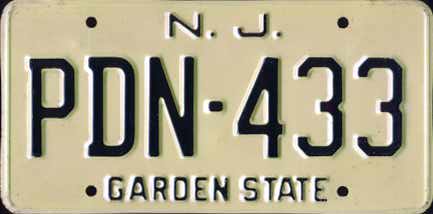 |
New Jersey undated passenger issue, circa 1969. The "black on buff" New Jersey plates were introduced in 1959 and issued through 1979 with some minor base changes. These plates remain valid today, with plate stickers having been introduced with late 1999 expirations. Plates in the "P" series tended to have been issued in 1968 or early 1969. |
 |
New Jersey undated passenger issue, circa 1970. Starting in mid- to late-1969, New Jersey plates carried an experimental reflective backing that was started with the RIA series of plates, then discontinued after plate number SZZ-999. New Jersey didn't return to plate reflectorization until the early 90s. Plates from this era can be difficult to date, but luckily I heard from another collector that he himself was issued a plate in this "RYV" series (a mere 69 plates lower than this one, in fact) in June, 1970. I'd guess that this one was issued probably within a day or two of his. |
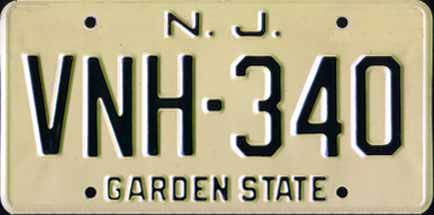 |
New Jersey undated passenger issue, circa 1971. Standard non-reflective black on buff plates were issued from plate number UAA-001 through the end of the series at YZZ-999. Plates in the "T" series were used for trailer registrations and not used within the passenger series. |
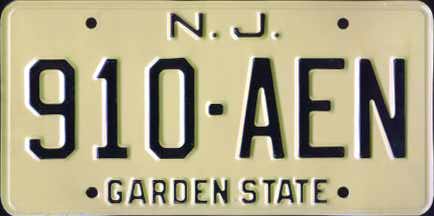 |
New Jersey undated passenger issue, circa 1973. When plate number YZZ-999 was reached in 1973, NJ switched to a reverse-series 123-ABC format. The "Z" series was not issued until approximately 1985, on a different baseplate. Plates of this era had a slightly lighter color of "buff" background. This plate would have been issued in approximately 1973 based on my estimates. |
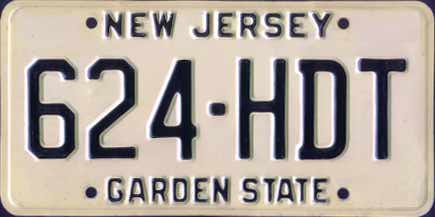 |
New Jersey undated passenger issue, circa 1977. Starting with plate number 100-HCA, the full state name was added to these plates. This was the first time in New Jersey plate history that the entire state name appeared on a plate. This variation existed through the end of the KZZ series, when the baseplate was changed for a new design. |
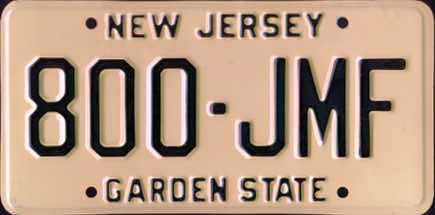 |
New Jersey undated passenger issue, circa 1978. Another of the fully embossed state name issues, this one uses an alternate state name die which appeared seemingly randomly throughout this stretch. The difference between the dies is most apparent when looking at the 'W' in 'NEW,' with this version being substantially wider than the other version. This particular plate also seems to have a much darker background color than others I've seen, again this tended to vary somewhat depending on the production run. |
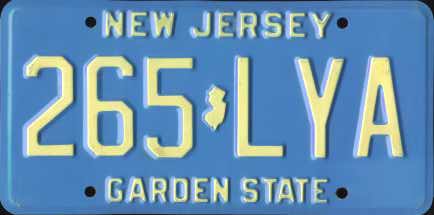 |
New Jersey undated passenger issue, circa 1979. These buff-on-blue plates were introduced in 1979 and started with plate number 100-LAA. Aside from the obvious color scheme changes (one of the uglier combinations in history, but in a nice way), a small state-shaped divider was also added to the plate. This base was issued through 1993 and these plates, although being phased out through attrition, can still be seen in great numbers on the road. |
 |
New Jersey undated passenger issue, circa 1985. When plate number 999-ZZZ was reached around 1985, the state went back and issued plates in the previously skipped ZAA-100 through ZZZ-999 series. Other previously-skipped combinations were also issued at this time to try to stretch out the sequence for a little longer. Eventually, all combinations were exhausted and a new format was introduced. |
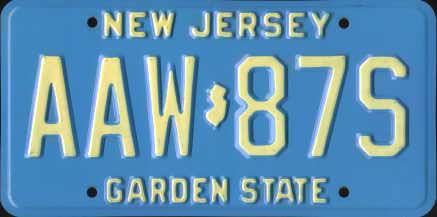 |
New Jersey undated passenger issue, circa 1985. Once the ZAA-ZZZ series and other combinations were used up, the series switched to this ABC-12D format. This format has also been used over the years by Florida and Texas on passenger issues. This series was used through 1993, and was discontinued ("suspended," actually - see the last couple plates on the page) at the end of the "H" series at HZZ-99Z. |
 |
New Jersey undated passenger issue, circa 1993. This new reflective baseplate was introduced in 1993 and was intended to replace all existing 1959-1993 plates. Rather than picking up the numbering series where the last plates left off, New Jersey opted for a new format altogether, and the seven-digit ABC1234 format was selected. These plates were very hard to read at a distance, however, so they were changed to an AB-123C format shortly thereafter. The seven digit plates were not recalled and can still be seen on the road. |
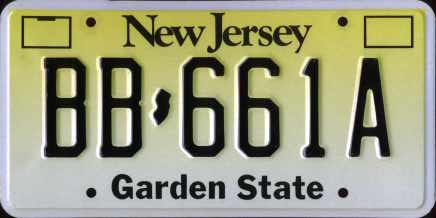 |
New Jersey undated passenger issue, circa 1994. This is one of the AB-123C format plates on the current graphic reflective base. This series began at plate number BA-100A, as the "A" series was skipped due to similarity with the seven-digit plates (the A series was later issued for apportioned truck plates starting in 1996). The state-shaped divider was also returned to the plates with the new format. This format lasted until mid-1998 when it was exhausted and replaced by a return to the ABC-12D format at JAA-10A (see 2000 plate). |
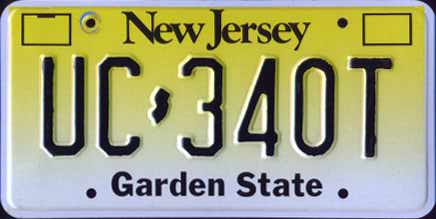 |
New Jersey undated passenger issue, circa 1998. Same series as above, this was one of a limited production run of reflective, screened New Jersey plates that were stamped onto older blue blanks. The result is a regular format current plate with a blue back and blue showing at the very edges of the plate. Blue paint can also be seen if the plate is scratched, as seen on the top left bolthole on this plate. |
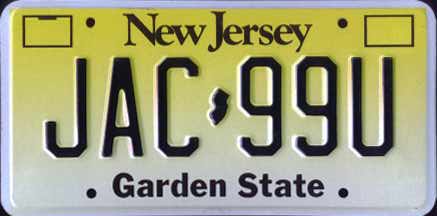 |
New Jersey undated passenger issue, circa 1999. In 1998, New Jersey ran out of combinations in the AB-123C numbering series and reverted back to where the 1979 series tan on blue plates had left off, at plate number JAA-10A. Plates in this format were initially issued without plate stickers, like every other issue from 1959 through 1999. Stickers were implemented starting with plates expiring in November, 2000, however (see next plate). |
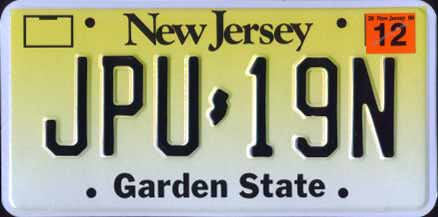 |
New Jersey 2000 passenger issue. Near the middle of the "J" series in this format, the state began using plate validation stickers on passenger plates for the first time. The first of these stickers expired in November, 2000. This was done as a result of more stringent emissions inspections being introduced to the state, so vehicle inspections (still noted by a windshield sticker) were changed to every two years. Yearly registrations remain, as indicated by the new plate stickers. Stickers can be used on any New Jersey plate from 1959 forward, so older plates are still not being completely replaced at this time. |
 |
New Jersey 2002 passenger issue. In 2001, the contract for producing the reflective background for New Jersey plates was awarded to the Avery Corporation, who also supplies material to a few other states (North Carolina, Ohio, Wisconsin for example). These plates have sort of a "sheen" to them, for lack of a better description. The Avery plates in New Jersey are also different in that the font for the state name has been increased slightly in size. This change is reported to have occurred around the late LGx series of plates, although the change was not a clean break and plates in the late LGx and early LHx series can be found on both bases. |
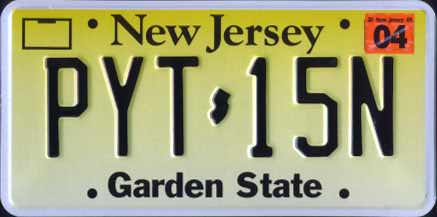 |
New Jersey 2005 passenger issue. Well, after joining the ever-growing number of states to start using Avery reflective sheeting in 2001, New Jersey also joined the ever-growing number of states to stop using the sheeting due to poor durability in early 2004. Avery, by all accounts, makes pretty good reflective sheeting for things like road signs, etc., but the stuff just doesn't seem to like being embossed. As a result, the sheeting cracks at the edges of the numbers and starts looking terrible, usually within only one or two years of use. New Jersey returned to using 3M materials at some point in the PXR/PXS series. |
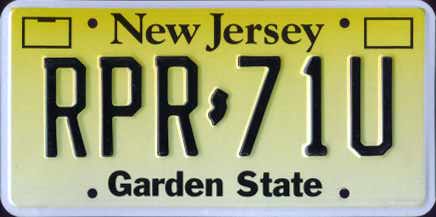 |
New Jersey undated passenger issue (circa exp. 2005). After a glorious five-year stretch of issuing perhaps the worst-made plate validation stickers in the history of adhesive products, New Jersey ended up discontinuing plate stickers in mid-2004. As a result, plates from the mid-R series and above will once again be valid without stickers. Law enforcement in the state apparently never quite embraced the idea of the plate stickers, so now they'll get to deal with vehicles bearing no outward proof of registration at all. |
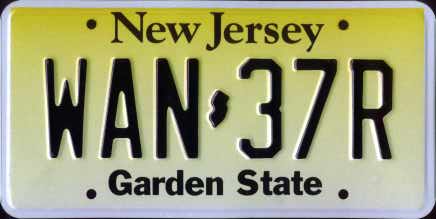 |
New Jersey undated passenger issue (circa exp. 2008). Having eliminated plate stickers after 2005, New Jersey apparently decided in 2007 that having the two prominent sticker boxes at the top corners of the plate was no longer necessary. These plates started appearing in mid-2007 in the latter part of the Vxx series. There apparently is not a clean break between the types, as the box-less type was first reported as early as VYX, but most of the VZx series did have the boxes. Plates from at least VZU forward seem to be consistantly without boxes. |
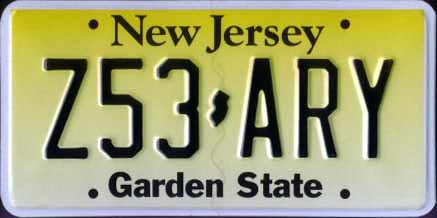 |
New Jersey undated passenger issue (circa exp. 2011). New Jersey ran out of available combinations in the ABC-12D series after ZZZ-99Z was reached in 2010. At that point the format was flipped to an A12-BCD format, with the plate remaining otherwise unchanged. The serial progression works the same on these plates as well, where on the old format AAA-99A would be followed by AAA-10B, on these A99-AAA was followed by B10-AAA, etc. This is a departure from the progression used by some other states which have used this format in the past (Texas, Florida) where the first letter has remained constant. Quebec also recently began using this format, progressing as the New Jersey version does. |
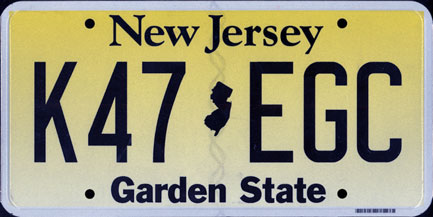 |
New Jersey undated passenger issue (circa exp. 2015). New Jersey began issuing flat plates in April, 2014, reportedly at the beginning of the EFF series. These plates use the same 3M serial font as South Dakota, Minnesota and several other states, with a larger, more detailed state shape separator than the old embossed version. A bar code was also added to the bottom right of the plate, the plate design remains otherwise unchanged. |
Additional New Jersey information provided by: Len Sokol, Howard, Bob Bittner, Jim Moini




















